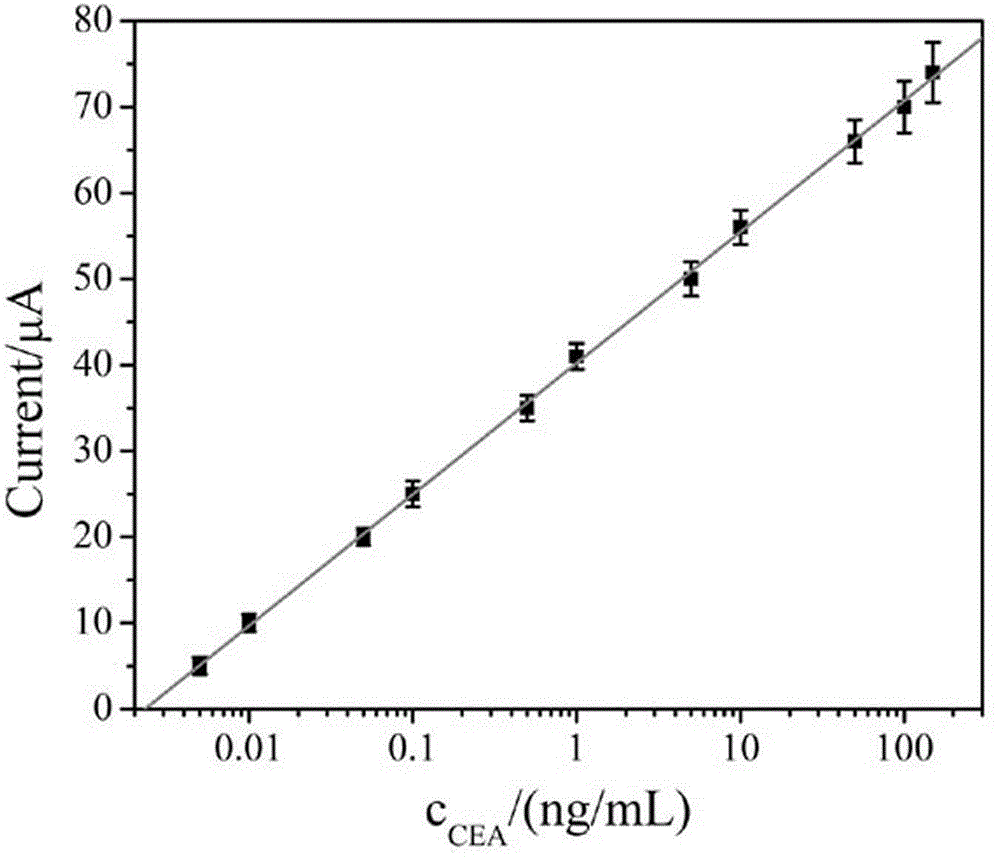Method for establishing electrochemical immunosensor for detecting carcino-embryonic antigen
A technology of immunosensor and construction method, which is applied in the field of electrochemical immunosensor, and can solve problems such as long analysis time, poor biocompatibility, and radiation hazards
- Summary
- Abstract
- Description
- Claims
- Application Information
AI Technical Summary
Problems solved by technology
Method used
Image
Examples
Embodiment 1
[0038] Example 1 Prepare an electrochemical immunosensor for detecting CEA standard samples.
[0039] Step 1. Preparation of PDDA-functionalized GR
[0040] a Preparation of graphene oxide: Add 100 mL of a mixed solution of phosphoric acid and concentrated sulfuric acid with a volume ratio of 1:9 into a three-neck flask, then weigh 0.75 g of graphite powder and add it to the above solution, heat to 30 °C, and add to the solution After adding 4.5 g of potassium permanganate, adjust the temperature of the water bath to 50 °C, and react for 12 h under magnetic stirring conditions. After the reaction stops, pour the sample into 300 mL of ice water with 4 mL of hydrogen peroxide added in advance, and stir thoroughly to obtain The mixture was separated by centrifugation, washed 7 times with ultrapure water, and then dried in a vacuum oven at 60 °C to obtain a brown-yellow graphene oxide solid;
[0041] b Preparation of GR: Dissolve 25 mg of the graphene oxide prepared in the above ...
Embodiment 2
[0054] Example 2 Prepare an electrochemical immunosensor for detecting serum samples containing CEA.
[0055] Step 1. Preparation of PDDA-functionalized GR
[0056] a Preparation of graphene oxide: Add 100 mL of a mixed solution of phosphoric acid and concentrated sulfuric acid with a volume ratio of 1:9 into a three-neck flask, then weigh 0.75 g of graphite powder and add it to the above solution, heat to 30 °C, and add to the solution After adding 4.5 g of potassium permanganate, adjust the temperature of the water bath to 50 °C, and react for 12 h under magnetic stirring conditions. After the reaction stops, pour the sample into 300 mL of ice water with 4 mL of hydrogen peroxide added in advance, and stir thoroughly to obtain The mixture was separated by centrifugation, washed 7 times with ultrapure water, and then dried in a vacuum oven at 60 °C to obtain a brown-yellow graphene oxide solid;
[0057] b Preparation of GR: Dissolve 25 mg of the graphene oxide prepared in th...
PUM
| Property | Measurement | Unit |
|---|---|---|
| quality score | aaaaa | aaaaa |
Abstract
Description
Claims
Application Information
 Login to View More
Login to View More - R&D
- Intellectual Property
- Life Sciences
- Materials
- Tech Scout
- Unparalleled Data Quality
- Higher Quality Content
- 60% Fewer Hallucinations
Browse by: Latest US Patents, China's latest patents, Technical Efficacy Thesaurus, Application Domain, Technology Topic, Popular Technical Reports.
© 2025 PatSnap. All rights reserved.Legal|Privacy policy|Modern Slavery Act Transparency Statement|Sitemap|About US| Contact US: help@patsnap.com

